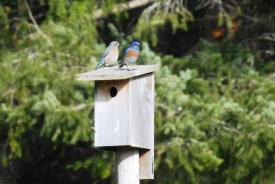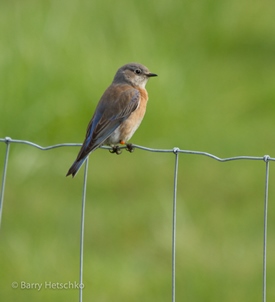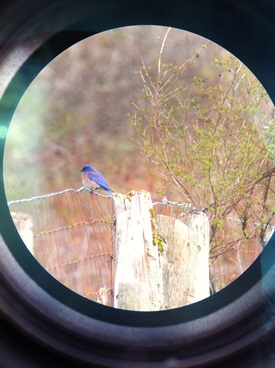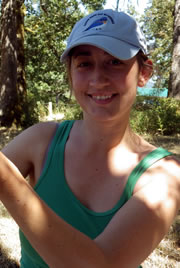The year the bluebirds stayed the winter

A pair of western bluebirds is spotted in March prospecting for nest boxes at a territory that has not been used by bluebirds since 2013. (Photo by Trudy Chatwin)
In Canada, conservation activities for the western bluebird normally begin in earnest in late March or early April, timed with the arrival of the first birds returning from migration to their breeding grounds. But it was only mid-January when we realized that this could be an exceptional year for Vancouver Island’s recovering western bluebird population.
The western bluebirds of the Salish Sea region of southwestern British Columbia and western Washington are considered short-distance migrators. In early autumn, they move south to wintering grounds in Oregon, California and even Mexico. Returning in late February and March, they are among the first of the migratory birds to reappear, heralding spring.
This year, however, it would seem that a surprisingly large number of the nearly 70 adults and juveniles that make up Vancouver Island’s reintroduced population did not migrate at all. After the Bring Back the Bluebirds project received confirmed reports of a few western bluebirds in Duncan in November and early December, followed by a sighting of two western bluebirds in Metchosin in December, we began to suspect as much, but there could be no mistaking that many were overwintering in the breeding area when a flock of eight to 14 western bluebirds was reported at Mount Tzuhalem Ecological Reserve near the Nature Conservancy of Canada's (NCC's) Chase Woods property in mid-January.

A paired female western bluebird is discovered by birders near her natal territory in March. This will be her first breeding season. (Photo by Barry Hetschko)
Thus, just as our latest project update was published to Land Lines in January, the western bluebird season was beginning on Vancouver Island, where we were experiencing an unseasonably warm winter. A similar-sized flock was reported in the ecological reserve by another observer in mid-February, and after that the reports of sightings came flooding in. As March progressed, the sightings of western bluebirds came increasingly from landowners in proximity to past breeding territories, suggesting that individuals were prospecting for nesting opportunities among the network of nestboxes that we had mounted throughout the area in recent years.
The photographs that were included with many of the reports from local birders partially captured the unique colour band combinations used to identify each bird, giving us hints about their identity. Piecing the information together, we determined that there were at least three females and six males — the highest return rate since reintroductions began in 2012 (a total of eight bluebirds returned in the spring of 2014).
By the time the project’s field operations were set to start on April 2, we were filled with hope that the altered migratory behaviour of the past winter had resulted in greater survival across the population and greater natal site fidelity among the youngest females, who have a tendency to pair up and remain with males they meet along their migration route. Sure enough, after only five days of surveying, so far we have confirmed seven breeding pairs and four as yet unpaired males, with many former territories and other ideal habitat areas still to be searched.
The known population consists of a mix of translocated and island-hatched individuals representing multiple generations — the greatest accomplishment of the recovery effort to date.

Fourth-year male Cody, glimpsed through a spotting scope at NCC's Cowichan Garry Oak Preserve, has been a part of the reintroduced population since 2012 when he was released as a fledgling with his family. (Photo by Reanna Shelling, GOERT)
The highlight so far has been spotting “Cody,” a fourth-year male, at NCC’s Cowichan Garry Oak Preserve on the first day back in the field. Cody had been translocated to Vancouver Island from southern Washington as a nestling with his family in 2012. He was released into the preserve, where he has returned each year, sometimes mating successfully sometimes not.
In addition to his impressive history, Cody is also impressive to see — even for a bluebird — as the plumage colour of males deepens with age.
With so much to report just one week into the western bluebird breeding season, the Bring Back the Bluebirds project is already looking forward to future updates for Land Lines readers. If our last post was any indication, many bluebirds may materialize before this is even published!
Bring Back the Bluebirds is led by the Garry Oak Ecosystems Recovery Team Society, in partnership with the Nature Conservancy of Canada, Ecostudies Institute, the Province of BC and the Cowichan Valley Naturalists’ Society.
Funders for 2015 include Disney Worldwide Conservation Fund, Habitat Conservation Trust Foundation, the James L. Baillie Memorial Fund of Bird Studies Canada, Mclean Foundation, Mountain Equipment Co-op, North American Bluebird Society, Sitka Foundation, TD Friends of the Environment Foundation, Public Conservation Assistance Fund, and private donors.
To learn more about the project and follow its progress, visit www.goert.ca/bluebird.


